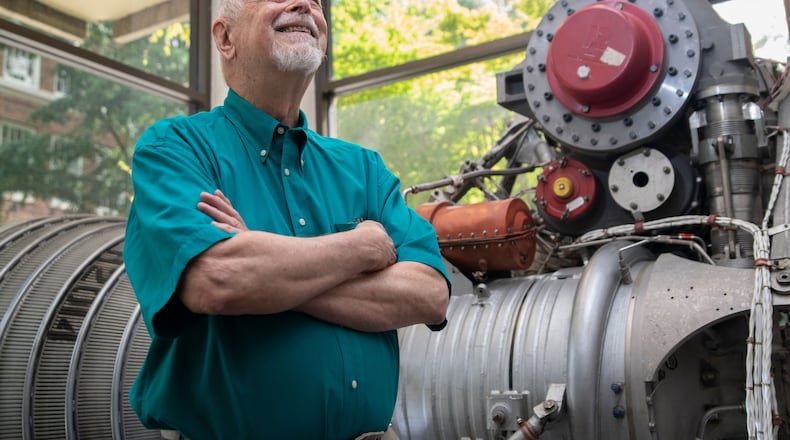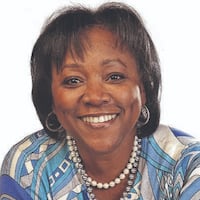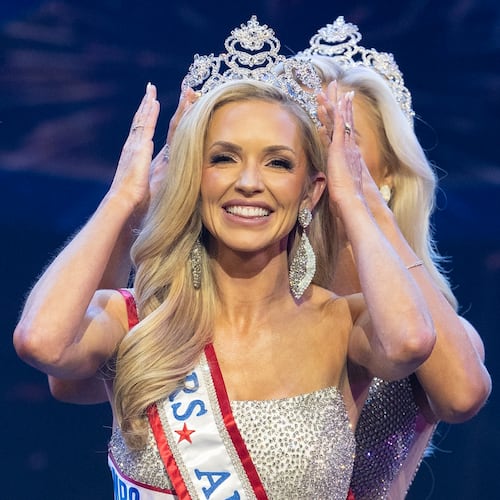Bob Macdonald was completing work on his master’s at Georgia Tech when President John F. Kennedy announced to a national television audience on May 25, 1961, plans to put a man on the moon and return him safely to Earth.
The very idea made the young engineer giddy with excitement.
“I thought what a great thing to do,” Macdonald remembered recently. “It wouldn’t be easy but we knew the physics and we knew the math. We just didn’t have the equipment to do it. That’s where the engineers came in.”
After graduating from Decatur High School in 1953, Macdonald had already earned a bachelor’s degree in chemical engineering and, after a brief stint designing air conditioning in F-100 fighter jets at North American Aviation, was set to graduate that spring with his master’s in nuclear engineering.
The first contracts to focus on the Apollo spacecraft engines had been awarded to Rocketdyne, a design and production company headquartered in Canoga Park, in the western San Fernando Valley of suburban Los Angeles.
“When I graduated, they were in full operation, adding people,” Macdonald said.
Tech and every engineering school in the country were inundated with recruiters. Macdonald was among those who interviewed and received an offer by mail. After loading a moving truck with everything he owned, he flew out to California to help build the J-2 rocket engine, one of five high-performance propulsion systems used in the second stage of the Saturn V launch vehicle. One J-2 engine would also be used in the Saturn V's third stage to launch the Apollo spacecraft to the moon and to return the astronauts to Earth after their mission was complete.
The J-2 engines contained hollow tubes from which liquid hydrogen was pumped to keep the inside of the engine cool. It fell to Macdonald to verify estimates that were made to ensure the inside temperatures remained low enough.
RELATED: Women redefining retirement
“I was doing these heat transfer calculations while the engines were being built,” Macdonald recalled. “At this time, computers were just in their infancy. I was using a slide rule. Occasionally I’d ask a computer programmer to run the numbers, but there were no desktop computers or timesharing systems. It was very primitive. If you got within 5%, you were doing good.”
When it was time to test the J-2, only the scientists were on hand. Macdonald would learn later that the engine worked fine and without any hiccups.
“Everybody was ecstatic,” he said.
After the initial testing proved successful, Macdonald left Rocketdyne for sister company Atomics International to work on a nuclear reactor to power space stations before finally returning in 1969 to Atlanta, where he reenrolled in Tech to earn a doctorate in nuclear engineering and eventually joined the faculty at Georgia State University, teaching of all things computer science.
Months later on July 20, 1969, he was at a friend’s home, his eyes glued to the television set like every other American, when Neil Armstrong and then Buzz Aldrin set foot on the moon for the first time.
Macdonald marveled as Apollo 11 settled on a level spot. Had it hit a boulder and tipped over, he said, they would’ve died before any rescue could’ve occurred.
“Had it not been for Armstrong, it would’ve ended in disaster,” he said.
We all know, of course, there was no disaster.
RELATED: How University of Georgia helped put a man on the moon
As he stepped off the ladder of the lunar module that day, Armstrong declared these immortal words: “That’s one small step for man, one giant leap for mankind.”
Macdonald gasped, proud of his contribution to history.
Credit: The Atlanta Journal-Constitution
Credit: The Atlanta Journal-Constitution
“It’s a real sense of satisfaction to have been able to do something like that,” he said. “You go to school; they train you to be able to take what you learn, apply it and have it work. It is immensely satisfying when things go as planned. I felt lucky to play a part.”
After nearly 15 years teaching at Georgia State, Macdonald landed a job with a textile manufacturer that had moved its engineering and research departments to Atlanta.
The company was starting a new venture producing non-woven fabrics but was having trouble with quality control. When it advertised for bids to add a control system to its machines, Macdonald submitted a proposal and won a $1 million contract, money he used to found Macdonald and Company, a software engineering venture.
He retired two years ago but recently became the oldest graduate student at Georgia Tech, enrolling in the Online Master of Science in Analytics program launched in 2017 by Georgia Tech Professional Education.
“If you’re not learning something new, you’re falling behind,” he said.
As America prepares to mark the anniversary of the Apollo moon landing this weekend, Macdonald, now 83 and living in Smyrna, couldn’t help remembering the day 50 summers ago with eyes focused on the future.
In five years, he predicted, America will finally make a return visit to the moon.
You heard it here first.
Find Gracie on Facebook (www.facebook.com/graciestaplesajc/) and Twitter (@GStaples_AJC) or email her at gstaples@ajc.com.
About the Author
The Latest
Featured




